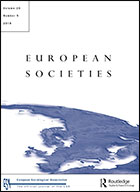New Article in “European Societies” | 26.11.2018What Does “Family” Actually Mean?
In the current issue of the journal European Societies, Dr. Detlev Lück and Kerstin Ruckdeschel present the results of two BiB studies on this topic. Both studies are intended to close a knowledge gap: Family research agrees that the differences in family forms and fertility rates in Europe also have to do with culturally different conceptions, but little is known about what the cultural conceptions of the family in Germany actually look like.
In one of the surveys, 5,000 young adults were interviewed over the phone using a standardized questionnaire. Among others, they were asked to state whether they considered seven different lifestyles to be a family or not. In the other survey, respondents were asked to draw a “real” family in their eyes. Afterwards, they were interviewed on the phone as well. However, there was no questionnaire used for this interview; instead, the participants could talk freely about what they had drawn and why.
Family Role Models between Unity and Diversity
At first sight, the findings of the two studies show very different outcomes. The Germans are very liberal and oriented towards inclusion in their assessment of the seven lifestyles. Every fourth person finds that all seven life forms stand for families - from the childless couple to the single parent and the step family to the same-sex couple with children. Most others see at least almost all of these life models as a family, for example all those in which children live. Hence, it can be concluded: The diversity of family forms has arrived in people's minds. The Germans know that family life is heterogeneous and appreciate this.
Family in Pictures
In comparison, it is first of all surprising that the “classical” nuclear family is very often drawn in the pictures: Father, mother and one to three children - sometimes with grandparents, a pet or a house in the countryside in the background. Although there are also some pictures that consciously try to depict an unconventional family-type or the diversity as a whole, even when talking on the phone, many participants report that when they hear the word “family” the “father-mother-child” vision first comes to their mind and that this is exactly what they wanted for themselves. To some extent, even people whose current family situation deviates considerably from this view are of this opinion.
The Nuclear Family Still Remains the Prototype Perceived for Family
Lück and Ruckdeschel come to the conclusion that young adults in Germany have a variety of ideas about the family, almost all of which are very open and very liberal. But they all involve the familiar image of the nuclear family as a kind of prototype for the family itself. How others live is and may be different; what people pursue for themselves is quite uniform: father, mother and (few) own children.
The article is part of the special issue “Family Understandings in Contemporary Europe” published by the journal European Societies. The editors of this issue are Dr. Detlev Lück from the BiB und Anna-Maija Castrén.

Detlev Lück and Kerstin Ruckdeschel (2018): Clear in its core, blurred in the outer contours: Culturally normative conceptions of the family in Germany. European Societies 20(5): 715-742.
